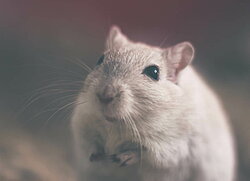Mikrotron MotionBLITZ EoSens® mini camera used in a neuropsychiatric disorders study at the University of California

In a study by scientists at the University of California, various responses were tested in mice. This forms the basis for research into neuropsychiatric disorders such as schizophrenia, obsessive-compulsive disorder and Tourette’s syndrome.
The startle response is an unconditional reflex, characterized by the rapid contraction of facial and skeletal muscles, to a sudden and intense startling stimulus such as a noise burst, air puff, or light flash. Studying the startle response has proven useful in identifying deficits in sensorimotor gating in many neuropsychiatric disorders including schizophrenia, obsessive compulsive disorder, Huntington’s disease, and Tourette syndrome. Research into the acoustic startle response of rodents has become a leading tool for studying the pathophysiology, pharmacology, and genetics of these disorders.
Study by University of California
The rodent startle response is typically assessed in stabilimeter chambers, and while these systems are excellent at measuring startle, they are designed only for this sole purpose. In a study by University of California scientists, a VideoFreeze system — a widely used tool for studying Pavlovian fear conditioning — was deployed instead to assess the acoustic startle response in freely moving mice. Observation of the startle response was conducted with the VideoFreeze’s standard 30 Hz camera and separately, by a Mikrotron MotionBLITZ EoSens® mini high-speed camera, to observe the response with greater temporal resolution by recording video at 1000 Hz.
Video acquisition was triggered by an output from VideoFreeze using a 28-volt to TTL converter so that the high-speed video could be correlated with the timing of startle stimulus presentation. The VideoFreeze system was running simultaneously so that the videos and data from the high-speed imaging system and the VideoFreeze system could be compared.
Animal movement within the digital video stream is quantified using a motion index, which is generated using a proprietary motion analysis algorithm that compares successive video frames while controlling for baseline video noise on a pixel-by-pixel basis.
Sample size of 16 mice
A sample size of 16 mice were presented with white noise burst stimuli of increasing intensities and movement was quantified via motion index scores derived from the video signal. Mice were first presented with 200 ms white noise bursts of increasing intensities and exhibited no startle responses to lower-intensity stimuli (75 dB to 90 dB) but significant startle responses to higher-intensity stimuli (95 to 120 dB). Video captured the mouse startle response characterized by significant nose, ear, back, and tail movements. The mouse startle response was captured by standard video, yet the progression of movement from rostral to caudal was more evident in the Mikrotron system.
While the Mikrotron MotionBLITZ EoSens® mini camera and the standard speed captured the startle response in a similar manner — they both rose sharply and remained elevated during the 200 ms noise burst — most of the motion that was resolved on a millisecond basis in individual frames in the high-speed recording was captured as motion blur in a single frame in the standard camera. The MotionBLITZ EoSens® mini camera delivered speeds of up to 523 frames per second at a resolution of 1,696 x 1,710 pixels to precisely capture extremely fast motion and the details of even the smallest objects.
For more information, please visit http://www.mikrotron.de.
News Categories
- » NEWS HOME
- » Automation & Robotics
- » Industry 4.0
- » Material Handling
- » Sensors
- » Quality & Testing
- » Machine Vision
- » Laser & Optics
- » Metalworking
- » Motion Control & Drives
- » Hydraulics & Pneumatics
- » Process Industry
- » Renewable Energy
- » Agriculture
- » Home & Office Furniture
- » Environmental Tech

